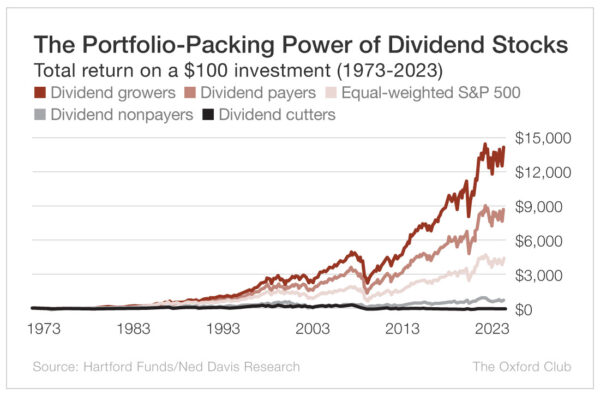How to buy OpenAI Stock?
If you’ve ever used the buzzy generative AI tool, ChatGPT then you may have wanted to buy stock in the parent company, OpenAI. OpenAI is a private company, so you can’t buy OpenAI stock directly. But, Microsoft (Nasdaq: MSFT) owns a major stake in OpenAI, which means you can get exposure to OpenAI by buying Microsoft stock. Let’s examine a few of the pros and cons of this strategy to see if it makes sense for you.
If you’re not interested in buying Microsoft then don’t worry, there are plenty of ways to benefit from the AI megatrend.
OpenAI Stock: What You Need to Know
As a private company, OpenAI is not obligated to tell the public anything about its business. This means it’s hard to find out information like how many users ChatGPT has or how much money OpenAI makes. But, there are a few bits of info that OpenAI has made public:
- $2 billion in revenue: According to Reuters, OpenAI hit $2 billion in revenue in December 2023. The generative AI startup is aiming to double this figure in 2024.
- $80 billion: Investors have valued OpenAI at $80 billion. However, this valuation likely fluctuates frequently.
- 900% growth rate: According to Sacra, OpenAI posted an annual recurring revenue of $2 billion in 2023. This was up from $36 million in 2021, which represents a growth rate of 900%. Not too shabby at all.
- Massively Expensive: OpenAI is one of the most capital-intensive startups in the world, meaning it costs a lot of money to run the company. It’s estimated that ChatGPT alone costs roughly $700,000 per day to operate, thanks to high costs for GPU hours and hardware.
- 24 AI Products: OpenAI is most well-known for ChatGPT. But, it has roughly two dozen different genAI products in total. This includes AI-based products for text, images, audio, and video.
How Does OpenAI Make Money?
Before buying OpenAI stock, it’s important to learn how the company makes money. This lets you know whether or not the company is growing. Additionally, some startups can achieve an immense valuation without actually making much money. ChatGPT makes money in two days:
- Subscription Revenue: OpenAI uses a “freemium” model. This means that it has a free version for most of its tools, along with a slightly better-paid version. For example, ChatGPT is free. But, ChatGPT Plus, starts at $20 per month. Sacra estimates that ChatGPT Plus revenue hit $100 million annually shortly after launching.
- Token System: OpenAI also licenses the use of its API for companies that are looking to build tools on top of its AI models. To do this, OpenAI has created a usage-based token system. Companies pay OpenAI depending on how much AI computing power they use. So, companies that use tons of AI computing power will pay OpenAI more than companies that just use a little.
Again, the specifics for most of OpenAI’s finances are not publicly available since the company is private. But, OpenAI works with some of the world’s biggest companies, like Microsoft. So, it’s safe to assume that OpenAI is doing quite well financially. Speaking of Microsoft, let’s examine how you can buy OpenAI stock.
Investing in OpenAI Stock
Unless you’re an accredited investor, the only real way to buy OpenAI stock is to buy Microsoft. Microsoft has made two strategic investments in OpenAI, so its stock could increase if OpenAI’s valuation surges. Here’s a quick history of Microsoft’s investments in OpenAI:
- 2019: Microsoft invested $1 billion in OpenAI roughly three years before it released ChatGPT.
- January 2023: Microsoft invested another $10 billion in OpenAI. This was roughly a third of OpenAI’s market value at the time.
If OpenAI becomes the world’s next trillion-dollar company then Microsoft will be one of the biggest beneficiaries. Additionally, Microsoft isn’t just a financial partner with OpenAI. The two companies have a special relationship since Microsoft is rapidly deploying AI across its range of products. On its last earnings call, CEO Satya Nadella stated,
“We’ve moved from talking about AI to applying AI at scale. By infusing AI across every layer of our tech stack, we’re winning new customers and helping drive new benefits and productivity gains across every sector.”
This means that AI is currently being implemented in products like Bing, Office 365, Azure, GitHub, and even Microsoft’s gaming verticals like xBox and Activision Blizzard. I’m making a bit of an assumption here. But, as a leader in AI, it’s safe to assume that Microsoft will be working closely with OpenAI to ensure it has the most up-to-date tech for its products. If you’re interested, you can read more about OpenAI and Microsoft’s unique partnership.
Additionally, Microsoft also recently partnered with Nvidia (Nasdaq: NVDA) to expand Nvidia’s tech across Azure, Azure AI services, Microsoft Fabric, and Microsoft 365. This is a bit unrelated to OpenAI. But, it will help secure Microsoft’s place as a leading AI company, as Nvidia is a goliath in the AI arms race.
With all that said, there are a few risks to note if you plan on buying Microsoft as a way of investing in OpenAI stock.
Downsides to Buying OpenAI Stock
Microsoft is a massive company. In 2023, it pulled in a whopping $211.92 billion in revenue and $72.36 billion in net income. So, Microsoft investing $10 billion into OpenAI might sound like a big investment (and it is…for a regular company). But, for Microsoft, $10 billion is a drop in the bucket compared to how much money the company brings in.
For OpenAI to have an outsized impact on Microsoft’s stock, OpenAI’s market capitalization would have to surge tremendously. Even if OpenAI grew from an $80 billion valuation to $100 billion, it wouldn’t really move the needle for Microsoft. Especially since Microsoft only owns a fraction of the company.
Additionally, buying Microsoft’s stock opens you up to other risks outside of OpenAI. For example, Microsoft could report declining growth for its Azure cloud line of business, which could hurt its stock price. If you own Microsoft, this would hurt you too – even though it has nothing to do with OpenAI. These are the other factors to be aware of when you plan on buying OpenAI stock through Microsoft.
I hope that you’ve found this article valuable when it comes to learning about how you can invest in OpenAI stock. If you’re interested in reading more, please subscribe below to get alerted of new articles from InvestmentU.
Read our article on one of OpenAI’s biggest competitors Anthropic here.
Disclaimer: This article is for general informational and educational purposes only. It should not be construed as financial advice as the author, Ted Stavetski, is not a financial advisor.
About Teddy Stavetski
Ted Stavetski is the owner of Do Not Save Money, a financial blog that encourages readers to invest money instead of saving it. He has five years of experience as a business writer and has written for companies like SoFi, StockGPT, Benzinga, and more.





